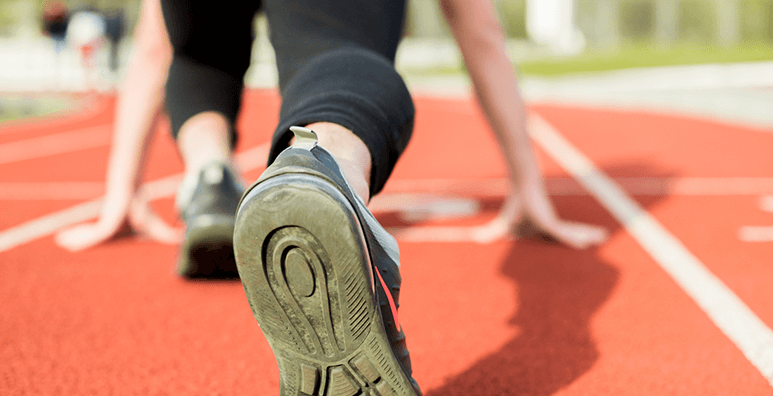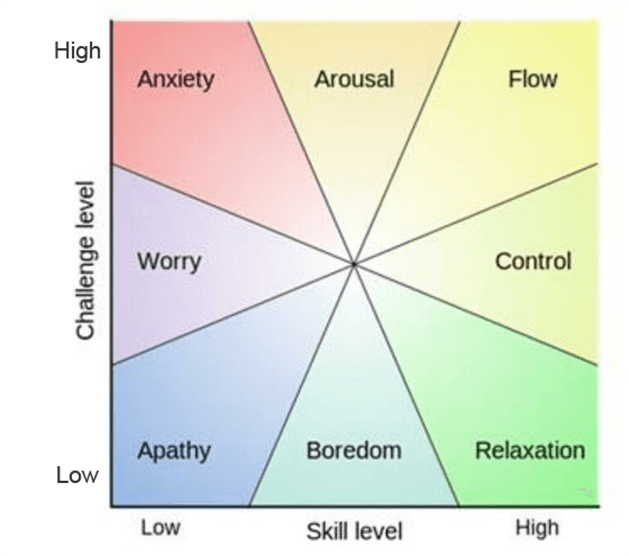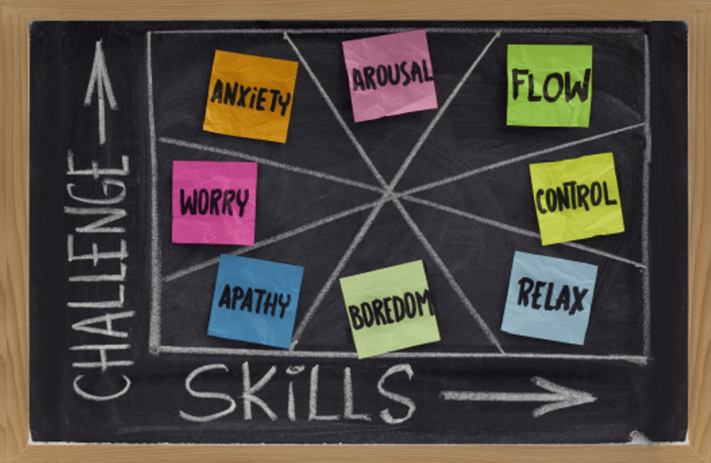
Click the button to start reading
How To Induce Flow State For Heightened Performance
Flow State can also be described as this feeling of deep concentration and high productivity being “in the zone.” You’re beyond distraction, riding a wave of steady creativity, and pouring your whole mind and body into the task before you.
You’re beyond the perception of time — completely absorbed in your task, blocking out all the noise. It’s the kind of productivity you wish happened more often — the type of concentration that should accompany every challenge.
The good news is that you’ve likely experienced this a few times already under specific circumstances. Flow State is not exclusive to those in athletics or in the creative arts — it’s completely achievable for everyone.
What Is Flow State?
Flow theory was first introduced in the late 1970s by Mihaly Csikszentmihalyi, a Hungarian psychologist with immense contributions to both positive and flow psychology. He became fascinated by artists who became so lost in their creative work, they would lose track of time and barely sleep or eat. He observed this phenomenon occurring in athletes and authors as well.
 In his influential book, Flow: The Psychology of Optimal Experience, he states:
In his influential book, Flow: The Psychology of Optimal Experience, he states:
“[Flow is] being completely involved in an activity for its own sake. The ego falls away. Time flies. Every action, movement, and thought follows inevitably from the previous one, like playing jazz. Your whole being is involved, and you’re using your skills to the utmost.”
Csikszentmihalyi theorizes that people are happiest when they’re in a state of flow as they’re so engaged in their work that they achieve supreme focus and hyperawareness. In his 2004 Ted Talk, Csikszentmihalyi explains that psychologists have found that the human mind can only attend to a certain amount of information at a time. Specifically, that number is 110 bits per second. For perspective, decoding speech takes about 60 bits of information per second. When you achieve flow state, you allocate all of these bits to the task at hand.
Put simply, achieving flow means being in a mental state where you find yourself so completely immersed in the task itself, you forget about the world around you. Your unique skills automatically take over at an unconscious level, which fuels your productivity. When your mind and body are working harmoniously, you no longer allow intrusive thoughts to distract you. Inducing Flow State brings a period of relaxed high performance that results in powerful outcomes.
Examples Of Flow State In Action:
Let’s take a look at some real-life examples of Flow State:
- Rappers – During a study done by the NIH to observe the difference in brain functions between improvised rap versus a rehearsed performance, it was theorized that “executive functions” were relaxed in order for more uncensored processes to take over, which could potentially be one of the pillars of creativity. During their performance, the rapper felt that they were outside of “conscious awareness” while doing spontaneous improvisation.

- Athletes – Before a race starts, an athlete is typically nervous about the possible outcome. As soon as they hear the gun go off, they’re in the zone, letting all distractions go, and not even feeling their exhaustion. They make it to the finish line, sometimes forgetting to give out high-gives or participate in celebration because they were so absorbed in their run, they forgot all else.
- Writing – One of the hallmarks of Flow State is for the experience to be rewarding. When authors are feeling particularly inspired and can imagine how satisfying it will feel to accomplish their writing goals, they can enter a flow state that enables them to produce to meet their writing goal…or maybe even a little more!
- Gamers – Games simplify the goal for you. It outlines what you need to accomplish, which allows your mind to focus your energy on achieving this goal. Nothing else matters at this point. Combine this with the adrenaline rush that usually accompanies a challenge, gamers can enter a flow state by trusting absolutely in their hand-eye coordination instead of overthinking the situation. Their minds and bodies are working together to achieve the intended outcome: to win!
The Ideal State To Induce Flow

(Source: ResearchGate)
In 1987, Csikszentmihalyi developed what’s now known as the Experience Fluctuation Model.
This combination of skill requirement and level of challenge is important in understanding what induces the Flow State. An individual is in a state of apathy (or very low interest in the task) when the activity requires little to no skill and is considered a low challenge. Conversely, when an individual is highly skilled but the challenge is low, they achieve a state of relaxation. However, if the challenge is high and the individual skill level is low, they will be in a state of anxiety.
The ideal state to induce flow is when the challenge and skill level are balanced. The mind is stimulated by the challenge and will utilize higher skill levels to complete the task.
It’s important to remember that In order for flow to occur, individuals must believe in their own skills. The key to unlocking flow is to have confidence that they can fully complete the task before them.
This is much easier said than done, of course. It takes time and practice to achieve a state that is rewarding in its outcome, tests and elevates our skills, and feels meaningful. For many people, the ingredients to induce flow are time, repetition, and resilience. For example, athletes require regular practice in order to develop their skills until it becomes habitual in nature. They’re able to achieve their goals by trusting in the skills they’ve worked so hard to gain and, over time, have built confidence in themselves through careful preparation.
What Are The Characteristics Of Flow State?
There are five factors that need to happen in order to achieve flow:
1. The activity needs to be intrinsically rewarding. It’s harder to induce flow when you’re doing a task that you have to do rather than something you want to do. This has a lot to do with our motivation as it relates to the activity.
2. There must be clear goals and a sense of progress. When a goal is clearly outlined, we’re able to embrace the methods we use to get to the finish line. It’s easier to own (and be proud) of our process, which leads to more confidence.
3. There must be clear and immediate feedback. We need to know what you’re doing, how to get to the goal, and where you’re going. The feedback that you get during and after your process — and the timing in which it happens — is crucial to improving and achieving greater levels of flow the next time you’re in the zone.
4. The challenge must match perceived skills (as outlined in the Experience Fluctuation Model). The ideal state of flow exists when the challenge and the skill level are a match.
5. There needs to be intense focus on the present moment. We can induce flow when we are free of external, and internal, distractions
When all these characteristics have been met, you’ll have an easier time achieving flow. You’ll know when you’re in this blissful state when you have feelings of serenity and no sense of time passing during this time of intense concentration.
Inducing a state of flow can be a surprising dichotomy when you take a step back and reflect on how you felt when you were in this type of mind space:
- Time stood still, but at the same time, it seemed to fly by.
- Felt effortless even though the activity was considered to be a challenge.
- The task itself was intense, yet you were relaxed.
- You’re more present than ever, but you’ve lost yourself (and sometimes where you were) while completing the task.

What Are The Benefits When You Induce Flow State?
There are a number of benefits when you enter the flow state including higher productivity, which is something we all strive to accomplish, but let’s dive deeper than this. Here are more of the meaningful advantages of inducing flow state:
- You engage in meaningful work. According to Csikszentmihalyi’s Ted Talk, when people are in flow, they’re more likely to enjoy their work, which leads to greater feelings of satisfaction and fulfillment.
- Your hyperfocus results in an optimal experience. Because of this state of intense concentration, you’re able to complete the task with a high-quality result within your particular zone of genius.
- You achieve success while tuning out all the noise. In a 2010 Harvard study, research showed that the average human mind wanders about 47% of the time. Combine this with our age of increased external distractions such as social media, streaming, news outlets, and notifications, we’re continuously more distracted throughout the day. By inducing flow state, you can shut out all the disruptions that get in the way of your success.
- You can be expansive with your creativity. Your mind can operate at a higher level, completely free of internal and external distractions. Intrusive thoughts that normally threaten your confidence and ability to complete the task will be nowhere to be found. This type of optimal performance enables you to think freely and without boundaries.
- You experience greater happiness. According to Frontier Psychology, an optimal experience of flow is likely related to “place identity” – the identity a person associates with oneself based on feelings of belongingness in their place of preference and the self-identifying activities they participate in. The more they are able to use their skills alongside higher challenges and engage in fulfilling work within their community, the happier they’ll be.
- You hone and enhance your skill set. In flow state, you can test your existing skill sets and unconsciously elevate them as you proceed through the challenge. A high level of skill and challenge must be equal in order to induce flow, so this eventually leads to continuous growth as you seek harder challenges.
- You develop more motivation. Your quality of satisfaction with the work, the process in how you arrived at the intended outcome, and how meaningful it is to you are directly related to your motivation to continue growing and improving. Because flow state can create a positive mindset, the more motivated you’ll be overall.
- You create emotional regulation. There’s a certain level of control associated with flow. As individuals continue to hone their skills in flow state, the more likely they’ll be able to develop the skills to regulate their emotions as well.

How to Induce Flow State
Now that we understand what Flow State is, how it works, and why it’s beneficial, it’s time to learn what you can do to induce Flow State, allowing an opportunity for your mind and body to be perfectly synchronized.
- Take care of yourself. You can more easily reach Flow State when you’re feeling more rested, which also means you’re less anxious. It’s best to be as relaxed as possible so you can function at your best when it comes time to work. Creating routines that are centered around your physical and emotional wellbeing can be a huge factor in inducing flow. For example, if a morning routine contains a trip to the gym, this may alleviate some of the pains you’ve been feeling and help you feel more energized. Also, if you have an exercise that you regularly do to calm your mind or practice daily meditations, this can relieve your anxiety. All of these simple steps that you likely already have in your routine can set you up to be in the right headspace.
- Choose the right tasks. Remember, it’s easier to induce flow when you’re doing something you love, rather than out of obligation. If you don’t find the activity particularly satisfying or meaningful, you might not be able to achieve the flow state. But it’s almost impossible to enjoy every piece of an activity. There’s bound to be something that seems mundane — something that doesn’t really inspire you. If you find yourself constantly bored of a task, it could be that the challenge is not high enough to keep your attention. In this case, it might be time to prioritize your tasks based on importance and meaning.
- Find an optimal working space. The working environment that we’re in can greatly influence our productivity and concentration. According to a study done by Princeton University, negative clutter can affect our ability to process information. It can make you feel more stressed, lessen creative thinking, and overload your senses, all of which are not conducive to inducing Flow State. It’s best to optimize your space or listen to music or soothing sounds, so it frees you up to concentrate and think creatively. A helpful tip in optimizing your workspace is to identify the distractions that hijack your focus.
- Practice. Flow state can’t be achieved if you’re just starting to learn a skill. When we refer back to the Experience Fluctuation Model, the higher your skill level (and the higher the challenge), the more likely you are to induce flow. The lower our skill, but the higher the challenge, will also result in more anxiety and fear. So before we try to induce flow, we need to practice and develop our skills.
- Repetition. Once we’ve learned the skill, it’s time to repeat it until we’ve achieved some level of competence or mastery. Let’s take writing a book as an example. If it’s an author’s first time writing a book, there will likely be some element of learning how to structure a plotline, develop characters, and build a compelling resolution. It’ll take some time for the author to practice new skills to rise to the higher challenge of mastering novel writing. Flow can then be achieved after repetition of these skills in practice (and after continuous feedback and editing in the revision process).
- Find a feedback system. One of the hallmark characteristics of inducing flow is receiving immediate feedback. It keeps your progress on track and alerts you if anything isn’t working in your process. For example, if you’re writing a paper, you need to be able to have someone in your corner to provide feedback — whether it would be good or bad — on the work and in a timely manner. Going too long without effective feedback can prevent your growth as you may not be aware that something may not be working to its potential.
- Identify a mindfulness technique. Even if you’re not a big believer in meditation or other mindfulness practices, it could be beneficial to learn one or two breathing exercises that are able to calm you down. It’s hard to keep your concentration when you’re feeling a heightened sense of anxiety or panic. Breathing techniques can help you calm down and relax instead of remaining in a state of increasing stress.

Getting Into The Flow
Inducing flow state can help cultivate a healthier mindset, which leads to higher productivity, greater satisfaction, and more happiness. Initially, this state of complete focus and heightened creativity seems to be more suited for those pursuing the arts or those in athletics, but it’s completely accessible to everyone no matter what field they’re in.
So long as you identify an activity you love, practice and refine your skills, and have an appropriate level of challenge, you’re taking the first steps in achieving flow. It isn’t easy, and it may cause you to explore other opportunities if you no longer feel inspired, but it’s well worth the reward.
















